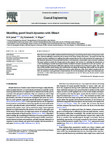Modelling gravel beach dynamics with XBeach
| dc.contributor.author | Jamal, MH | |
| dc.contributor.author | Simmonds, David | |
| dc.contributor.author | Magar, V | |
| dc.date.accessioned | 2018-12-12T12:13:06Z | |
| dc.date.available | 2018-12-12T12:13:06Z | |
| dc.date.issued | 2013-10-03 | |
| dc.identifier.issn | 0378-3839 | |
| dc.identifier.issn | 1872-7379 | |
| dc.identifier.uri | http://hdl.handle.net/10026.1/13020 | |
| dc.description.abstract |
Numerical cross-shore profile evolution models have been good at predicting beach erosion during storm conditions, but have difficulty in predicting the accretion of the beach during calm periods. This paper describes the progress made in modifying and applying the public domain XBeach code to the prediction and explanation of the observed behaviour of coarse-grained beaches in the laboratory and the field under accretive conditions. The paper outlines in details the changes made to the original code (version 12), including the introduction of a new morphological module based upon Soulsby's sediment transport equation for waves and currents, and the incorporation of Packwood's infiltration approach in the unsaturated area of the swash region. The competence of this modified model during calm conditions for describing the steepening of the profile, and the growth of the beach berm is demonstrated. Preliminary results on the behaviour of the beach subject to both waves and tides are presented. Good agreement is found between the model simulations and large-scale laboratory measurements, as well as field observations from a composite beach in the UK. The reasons for the model's capabilities are discussed. © 2014 Elsevier B.V. | |
| dc.format.extent | 20-29 | |
| dc.language | en | |
| dc.language.iso | en | |
| dc.publisher | Elsevier | |
| dc.subject | Numerical modelling | |
| dc.subject | Infiltration | |
| dc.subject | Sediment transport | |
| dc.subject | Accretion | |
| dc.subject | Berm | |
| dc.subject | XBeach model | |
| dc.title | Modelling gravel beach dynamics with XBeach | |
| dc.type | journal-article | |
| dc.type | Article | |
| plymouth.author-url | https://www.webofscience.com/api/gateway?GWVersion=2&SrcApp=PARTNER_APP&SrcAuth=LinksAMR&KeyUT=WOS:000337212300002&DestLinkType=FullRecord&DestApp=ALL_WOS&UsrCustomerID=11bb513d99f797142bcfeffcc58ea008 | |
| plymouth.volume | n/a | |
| plymouth.publication-status | In preparation | |
| plymouth.journal | Coastal Engineering | |
| dc.identifier.doi | 10.1016/j.coastaleng.2014.03.006 | |
| plymouth.organisational-group | /Plymouth | |
| plymouth.organisational-group | /Plymouth/Faculty of Science and Engineering | |
| plymouth.organisational-group | /Plymouth/Faculty of Science and Engineering/School of Engineering, Computing and Mathematics | |
| plymouth.organisational-group | /Plymouth/PRIMaRE Publications | |
| plymouth.organisational-group | /Plymouth/REF 2021 Researchers by UoA | |
| plymouth.organisational-group | /Plymouth/REF 2021 Researchers by UoA/UoA12 Engineering | |
| plymouth.organisational-group | /Plymouth/Research Groups | |
| plymouth.organisational-group | /Plymouth/Research Groups/Marine Institute | |
| plymouth.organisational-group | /Plymouth/Users by role | |
| plymouth.organisational-group | /Plymouth/Users by role/Academics | |
| dc.identifier.eissn | 1872-7379 | |
| dc.rights.embargoperiod | Not known | |
| rioxxterms.versionofrecord | 10.1016/j.coastaleng.2014.03.006 | |
| rioxxterms.licenseref.uri | http://www.rioxx.net/licenses/all-rights-reserved | |
| rioxxterms.type | Journal Article/Review |


